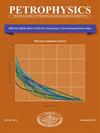核光谱学测井史
IF 0.7
4区 工程技术
Q3 ENGINEERING, PETROLEUM
引用次数: 4
摘要
本文提供了从1939年开始到今天测井中的核光谱学的历史。在伽马测井的发明和实施之后,本文追溯了脉冲中子捕获测井、光谱伽马测井、碳氧测井、示踪剂识别测井、小直径储层表征工具以及地球化学测井的技术发展。核光谱学的关键是探测伽马射线、它们的能量以及它们的母原子核的身份。由此可以更好地理解地层的性质。技术上的许多进步导致了核光谱学工具的现状。最值得注意的是检测伽马射线存在的能力。在此之后,闪烁体晶体探测器技术、脉冲中子发生器、伽马射线脉冲的能量数字化、快速计时电子设备和强大的计算机取得了许多进步。这些进步使我们今天拥有的以伽马射线为中心的复杂测井工具成为可能,这些工具帮助能源行业的石油工程师定位和生产碳氢化合物、干酪根和天然气储层,造福于世界上的每一个人。本文论述了这些历史发展的丰富历史。本文章由计算机程序翻译,如有差异,请以英文原文为准。
A History of Nuclear Spectroscopy in Well Logging
This paper provides a history of nuclear spectroscopy in well logging from its beginnings in 1939 up until the present day. After the invention and implementation of gamma ray logging, this paper traces the technological development of the pulsed-neutron capture (sigma) log, the spectral gamma ray log, the carbon-oxygen log, tracer identification logs, small-diameter reservoir characterization tools, and finally the geochemical log. The key to the science of nuclear spectroscopy has been the detection of gamma rays, their energies, and the identity of their parent atomic nuclei. From this, the properties of the formation can be better understood. There have been many advances in technology that have led to the current state of nuclear spectroscopy tools. The most notable has been the ability to detect the presence of a gamma ray. After this came numerous advances in scintillator crystal detector technology, the pulsed-neutron generator, the energy digitization of gamma ray pulses, fast-timing electronics, and powerful computers. These advances have made possible the complex, gamma ray-centric logging tools that we have today that have helped petroleum engineers in the energy industry locate and produce hydrocarbon, kerogen, and natural gas reservoirs for the benefit of each individual in the world. This paper discusses the rich history of these historic developments.
求助全文
通过发布文献求助,成功后即可免费获取论文全文。
去求助
来源期刊

Petrophysics
地学-地球化学与地球物理
CiteScore
1.80
自引率
11.10%
发文量
40
审稿时长
>12 weeks
期刊介绍:
Petrophysics contains original contributions on theoretical and applied aspects of formation evaluation, including both open hole and cased hole well logging, core analysis and formation testing.
 求助内容:
求助内容: 应助结果提醒方式:
应助结果提醒方式:


